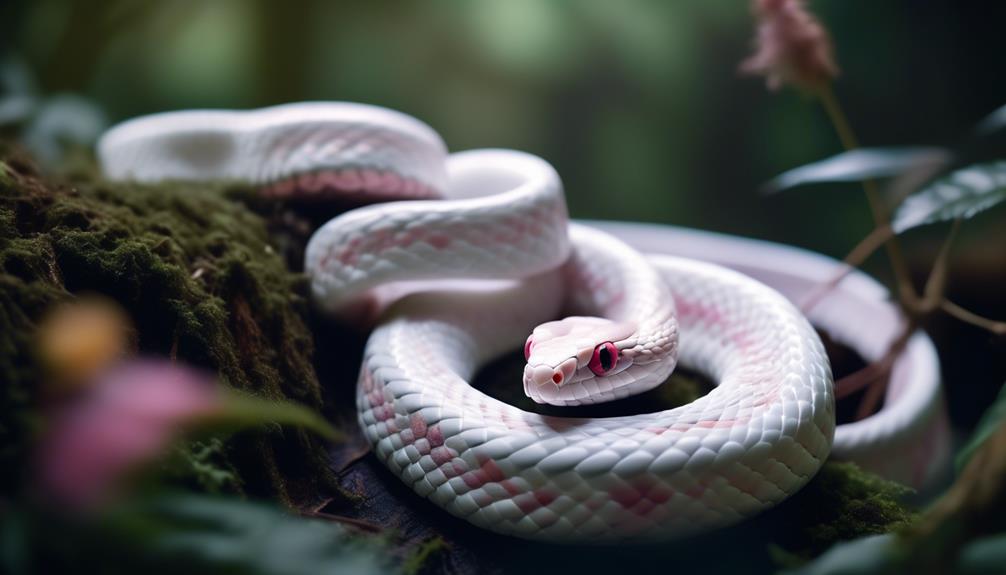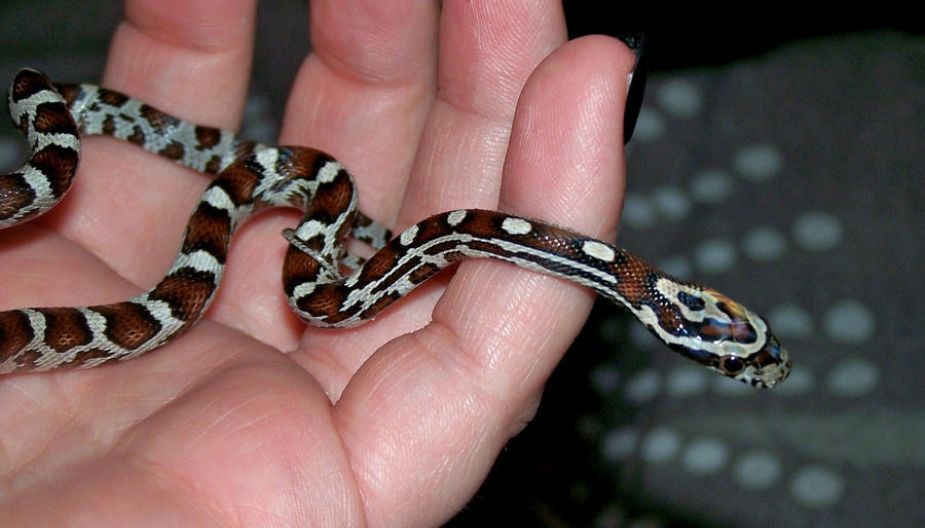Step into the world of the red-hot corn snake, where the vibrant hues of crimson and fiery orange collide to create a mesmerizing spectacle. As you explore the unique beauty of this stunning reptile, you'll uncover the secrets of its distinctive appearance and learn how to care for and appreciate this captivating creature.
But there's more to the red-hot corn snake than meets the eye. Discover the intriguing details that make this species a fascinating addition to any reptile enthusiast's collection.
And if you want to delve deeper into the world of reptiles, be sure to visit Freptiles, a leading website for reptile enthusiasts.
Anatomy and Physical Characteristics
While some variations exist, the typical adult corn snake measures around 3 to 5 feet in length and has a slender, muscular body covered in smooth scales that give it a glossy appearance.
This snake's physical features are a marvel of nature's design. Its head is distinguished by a prominent, angular shape and has vibrant scales that add an air of elegance.
The corn snake exhibits a wide array of color variations, from the classic vibrant red-orange with bold black-edged blotches, to the more subdued hues of gray, brown, and even lavender. These color variations are further complemented by the mesmerizing patterns that adorn its entire body, including the underside.
The dorsal scales form intricate patterns that are unique to each snake, adding to the allure of this species. The ventral scales, on the other hand, exhibit a checkerboard pattern, with alternating colors creating a visually striking impression.
The corn snake's physical features and color variations make it a truly captivating creature, showcasing the beauty and diversity found in the natural world.
Habitat and Enclosure Setup
With its unique physical characteristics in mind, the corn snake's habitat and enclosure setup must closely mimic its natural environment to ensure its well-being and health. To achieve this, consider the following essential elements for creating an ideal habitat for your corn snake:
- Temperature Gradient: Corn snakes require a temperature gradient in their enclosure to mimic their natural habitat. Provide a thermal gradient ranging from 75-85°F on the cooler end to 85-90°F on the warmer end. This allows the snake to regulate its body temperature effectively.
- Hiding Spots: Incorporate multiple hiding spots within the enclosure. Use artificial shelters, driftwood, or half logs to provide secure hiding places. This helps to reduce stress and makes the snake feel safe in its environment.
- Substrate Options: Choose a suitable substrate that retains moisture and aids in maintaining humidity levels. Aspen shavings, cypress mulch, or coconut husk are excellent choices, providing a natural feel while facilitating burrowing.
- Humidity Levels: Maintain humidity levels between 40-60% in the enclosure. This can be achieved by misting the enclosure and ensuring the substrate is moist but not waterlogged.
Creating an environment that meets these specifications will help ensure the well-being and contentment of your corn snake.
Feeding and Diet Requirements
To ensure the optimal health and nutrition of your corn snake, understanding its feeding and diet requirements is crucial for its well-being.
Corn snakes are carnivorous reptiles with specific nutritional needs. A feeding schedule for adult corn snakes typically consists of offering appropriately sized prey once every 7-10 days, while younger snakes may require more frequent feeding. It's essential to provide prey items that are approximately the same width as the snake's widest body part to prevent regurgitation or other digestive issues. When selecting prey size, consider the snake's age and size to ensure it can consume the prey without difficulty.
Feeding techniques are also important to consider. Live prey can pose a risk to the snake, as it may result in injury. Therefore, it's generally recommended to feed pre-killed prey to minimize the chance of harm to your snake. Additionally, always supervise feeding to ensure the snake consumes the prey properly.
Understanding and meeting the feeding and diet requirements of your corn snake is crucial for its overall health and well-being. By providing the appropriate prey size and following safe feeding techniques, you can help ensure the longevity and vitality of your captivating corn snake.
Handling and Temperament
Handling a corn snake requires a gentle and deliberate approach to ensure the safety and comfort of both you and the snake. Corn snakes, though generally docile, can become stressed if mishandled or if their environment isn't conducive to their needs.
To ensure a positive handling and socialization experience, consider the following:
- Behavior and Socialization: Understanding the behavior of corn snakes is crucial for successful handling. These snakes are solitary by nature and may exhibit defensive behaviors when feeling threatened. However, with regular, gentle handling, they can become accustomed to human interaction and may even enjoy being handled.
- Training and Interaction: When handling a corn snake, it's important to approach them calmly and confidently. Avoid sudden movements or loud noises that may startle them. Start with short handling sessions and gradually increase the duration as the snake becomes more comfortable. This helps to build trust and confidence in both the snake and the handler.
Breeding and Reproduction
Breeding corn snakes is a fascinating and intricate process that involves careful consideration of environmental factors and the reproductive cycles of these captivating reptiles. Mating behavior in corn snakes is often preceded by a period of brumation, a hibernation-like state, to simulate the natural seasonal changes they'd experience in the wild.
During this time, the male will exhibit increased activity and may engage in courtship rituals such as rubbing the female with his chin or body. Once the mating behavior is observed, the female will lay a clutch of eggs, typically ranging from 10 to 30 eggs, in a suitable nesting site.
Genetic diversity plays a crucial role in successful breeding programs, as it helps maintain a healthy population and reduces the risk of genetic diseases. Selective breeding is often employed to enhance desirable traits such as coloration and pattern variations in offspring. This process involves carefully choosing breeding pairs with specific genetic characteristics to produce offspring with the desired traits.
Frequently Asked Questions
Can Corn Snakes Be Trained to Do Tricks or Perform Certain Behaviors?
Yes, corn snakes can be trained to perform certain behaviors through snake training and behavioral conditioning. With patience and consistency, you can teach them to do tricks like climbing, target training, and even recognize their names.
What Kind of Enrichment Activities Can Be Provided for Corn Snakes in Captivity?
To provide enrichment activities for your corn snake in captivity, create a natural habitat simulation. Include branches for climbing, hiding spots, and varied substrates. Offer behavioral stimulation through scent trails, feeding puzzles, and different textures for exploration.
Are There Any Unique Health Concerns or Common Illnesses That Affect Corn Snakes?
When handling a corn snake, be gentle and avoid stressing it during shedding. Common health concerns include respiratory infections and parasitic diseases. Ensure proper humidity levels and cleanliness in their habitat to prevent these issues.
How Can I Tell if My Corn Snake Is Male or Female?
So, you want to get into snake breeding, huh? Well, to determine your corn snake's gender, you'll need to get into some reptile genetics. Look for hemipenes and tail length to identify males and females.
Are There Any Specific Color Variations or Morphs of Corn Snakes That Are Particularly Rare or Prized by Collectors?
There are specific color variations or morphs of corn snakes that are prized by collectors, such as the Albino morph. However, breeding challenges can make these rare variations even more valuable and sought after.
Conclusion
In conclusion, the red-hot corn snake is a stunning creature with its fiery crimson scales and sleek body. Its docile nature and low-maintenance care make it a popular choice for reptile enthusiasts.
However, despite its striking appearance, this snake's beauty is matched by its gentle temperament, making it a truly captivating and rewarding pet to have in your home.
If you want to learn more about caring for red-hot corn snakes and other fascinating reptiles, visit Freptiles, a leading website for reptile enthusiasts.


